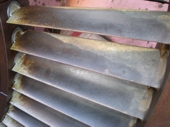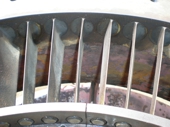Set IGVs for Maximum Efficiency
 Have your combustion turbines been losing power after overhauls? There are many factors which can affect power production, but the IGV settings are one area that even the OEM can overlook.
Have your combustion turbines been losing power after overhauls? There are many factors which can affect power production, but the IGV settings are one area that even the OEM can overlook.
We recently helped a plant with three GE Frame 6B gas turbines that had lost power over successive overhauls. Units 1 and 2 had been overhauled by the OEM in the last few years and Unit 3 had been overhauled in 2006 by a competitor. All three units had been experiencing an unexplained loss of power.
 A gas turbine needs to breathe air – and a lot of it – to make horsepower. The inlet guide vanes (IGVs) on a heavy duty gas turbine are designed to modulate (open and close) in response to commands from the control system to regulate this air flow. These commands control turbine exhaust temperature, protect against a compressor “stall” or “surge” (extremely damaging to the compressor blading), and other controlling functions. The IGVs look like little airplane wings that rotate or pivot to allow more or less air into the compressor. They are calibrated to the turbine control system by measuring the actual vane angles with a machinist’s protractor and inputting the readings into the control system. This lets the electronic controls know physically where they are so that the system can properly control the unit.
A gas turbine needs to breathe air – and a lot of it – to make horsepower. The inlet guide vanes (IGVs) on a heavy duty gas turbine are designed to modulate (open and close) in response to commands from the control system to regulate this air flow. These commands control turbine exhaust temperature, protect against a compressor “stall” or “surge” (extremely damaging to the compressor blading), and other controlling functions. The IGVs look like little airplane wings that rotate or pivot to allow more or less air into the compressor. They are calibrated to the turbine control system by measuring the actual vane angles with a machinist’s protractor and inputting the readings into the control system. This lets the electronic controls know physically where they are so that the system can properly control the unit.
On checking Unit 1 and 2, the IGV calibration was significantly out of calibration. Unit 3 wasn’t as bad but it was also slightly out of calibration., We accurately calibrated the IGV’s to the OEM control specifications on all three units.
The results of this work were impressive. The heat rate (fuel efficiency) improved on Unit 1 by about 2%, gained 2.5 mw on Unit 2 and 0.5 mw on Unit 3. This made a significant contribution to the customer’s bottom line at the expense of just a few days of work.
The IGV calibrations are just one of the critical instruments or calibrations that could affect power production. Contact PSG® for a full analysis of any reductions to the heat rate or power output of your turbine
